In This Issue:
- Healthy Tributaries Provide Clean Water for the Hudson: 2021 Highlights
- Removing Barriers to Free-Flowing Streams
- Reconnecting Watersheds and Improving Road Infrastructure
- Planting Along Streams to Create Healthy Buffers
- Monitoring Water Quality in the Saw Kill River
- Collecting Real-Time Environmental Data
- Pilot Study to Monitor HABs in the Hudson River
Healthy Tributaries Provide Clean Water for the Hudson River
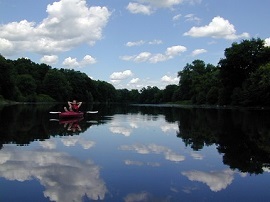 Water quality in the Hudson River estuary and the web of life it nourishes depends on the health of the many tributary streams and rivers that flow into its waters. Tributaries provide essential habitat for fish and wildlife and drinking water for millions of people. The Hudson River Estuary Action Agenda provides a blueprint for the future protection and restoration of these tributaries and the watersheds that surround them. We provide funding and technical assistance to help landowners, community leaders, municipal officials, and watershed groups carry out this important work. The Hudson River Watershed Alliance, the NYS Water Resources Institute, and NEIWPCC are key partners in this effort. Water quality in the Hudson River estuary and the web of life it nourishes depends on the health of the many tributary streams and rivers that flow into its waters. Tributaries provide essential habitat for fish and wildlife and drinking water for millions of people. The Hudson River Estuary Action Agenda provides a blueprint for the future protection and restoration of these tributaries and the watersheds that surround them. We provide funding and technical assistance to help landowners, community leaders, municipal officials, and watershed groups carry out this important work. The Hudson River Watershed Alliance, the NYS Water Resources Institute, and NEIWPCC are key partners in this effort.
Removing Barriers to Free-Flowing Streams
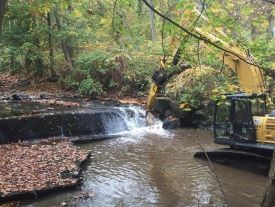 Each year, migratory fish navigate from the tidal Hudson to stream habitats to move between feeding, nursery, and spawning grounds. Many culverts and dams are blocking fish movement, dramatically shrinking the habitat available. There are more than 1,600 dams and 10,000 culverts in the estuary watershed. Removing these barriers and rebuilding culverts restores free flowing streams for fish and also improves water quality and reduces flood risk. Each year, migratory fish navigate from the tidal Hudson to stream habitats to move between feeding, nursery, and spawning grounds. Many culverts and dams are blocking fish movement, dramatically shrinking the habitat available. There are more than 1,600 dams and 10,000 culverts in the estuary watershed. Removing these barriers and rebuilding culverts restores free flowing streams for fish and also improves water quality and reduces flood risk.
DEC grant funding helps communities assess and replace these barriers. In the fall of 2021, Riverkeeper, in partnership with DEC, removed two obsolete dams on tributaries to the Hudson: the Strooks Felt Dam on the Quassaick Creek in Newburgh, and a dam on Furnace Brook in Oscawana Park in Cortlandt. The dams were the first barriers for fish movement upstream from the Hudson River. Removing the dams is improving water quality and habitat for resident and migratory fish, including river herring and American eel. DEC and partners are monitoring the streams to see how the dam removals may have benefited water quality and habitat. Free-flowing natural conditions now extend upstream at both locations. Funding for the dam removals was provided by the NYS Environmental Protection Fund (EPF), administered by Hudson River Estuary Program with grants for Tributary Restoration and Resilience.
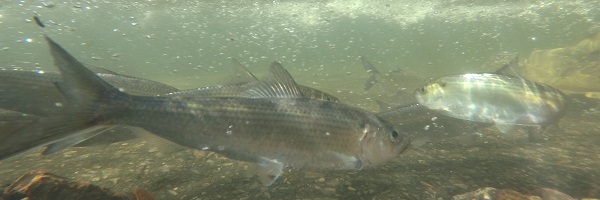
Reconnecting Watersheds and Improving Road Infrastructure
 In 2021, the Estuary Program, in partnership with NEIWPCC, awarded a contract to the engineering firm Tighe & Bond to work with the communities of Red Hook and Milan to create management plans for the road-stream crossings in both towns and produce preliminary designs for the highest priority sites. The two towns are both within the Saw Kill watershed and recognize the importance of working at a watershed scale on reconnecting streams using resilient infrastructure. In addition to fragmenting stream habitat for migratory fishes, crossings such as culverts and bridges may also contribute to localized flooding and be a costly maintenance burden for municipalities. Three conceptual designs for replacement structures will be produced for each municipality. Installing culverts that are passable to fish and sized for intense rain events will improve stream connectivity and community resilience to climate change. In 2021, the Estuary Program, in partnership with NEIWPCC, awarded a contract to the engineering firm Tighe & Bond to work with the communities of Red Hook and Milan to create management plans for the road-stream crossings in both towns and produce preliminary designs for the highest priority sites. The two towns are both within the Saw Kill watershed and recognize the importance of working at a watershed scale on reconnecting streams using resilient infrastructure. In addition to fragmenting stream habitat for migratory fishes, crossings such as culverts and bridges may also contribute to localized flooding and be a costly maintenance burden for municipalities. Three conceptual designs for replacement structures will be produced for each municipality. Installing culverts that are passable to fish and sized for intense rain events will improve stream connectivity and community resilience to climate change.
Planting Along Streams to Create Healthy Buffers
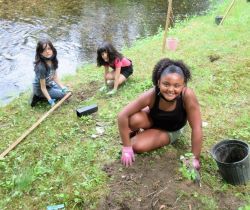 In 2021, the Hudson Estuary Trees for Tributaries planted over 4,800 native trees, shrubs, and grasses along 1.5 miles of stream with the help of more than 600 volunteers-- its largest streamside planting season in seven years. In this banner year, we revegetated an area along the Furnace Brook in Westchester County’s Oscawana park in Cortlandt and along the Quassaick Creek in Newburgh where Estuary Program staff worked with Riverkeeper to remove dams in 2021. We also finished up a 10-year project to replant two acres of floodplain along the Wallkill River in Benedict Farm Park with the Town of Montgomery Conservation Advisory Committee. Completed in May 2021, this decade-long project included eight planting events and 835 plants with volunteers contributing over 325 hours of time. In 2021, the Hudson Estuary Trees for Tributaries planted over 4,800 native trees, shrubs, and grasses along 1.5 miles of stream with the help of more than 600 volunteers-- its largest streamside planting season in seven years. In this banner year, we revegetated an area along the Furnace Brook in Westchester County’s Oscawana park in Cortlandt and along the Quassaick Creek in Newburgh where Estuary Program staff worked with Riverkeeper to remove dams in 2021. We also finished up a 10-year project to replant two acres of floodplain along the Wallkill River in Benedict Farm Park with the Town of Montgomery Conservation Advisory Committee. Completed in May 2021, this decade-long project included eight planting events and 835 plants with volunteers contributing over 325 hours of time.
Through a collaboration with the Town of New Lebanon’s Conservation Advisory Council, volunteers planted 520 trees and shrubs to create a new, 600 feet-long, streamside forest along a tributary to the Wyomanock Creek at Shatford Municipal park in Columbia County. Additional large plantings of trees and shrubs took place in Hastings-On-Hudson along a stream to the Saw Mill River, and in the town of Gardiner along the Walkill River. Trees planted along streams help protect water quality, fish and wildlife, and also reduce erosion and flooding.
(Photo of Benedict Farm volunteers by Bernadette Hennigan-DeMaro)

Monitoring Water Quality in the Saw Kill River
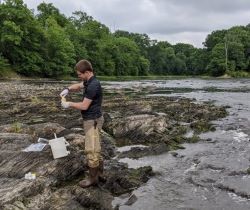 The Saw Kill River is a direct tributary to the Hudson River, with its watershed spanning over 16,000 acres. Its headwaters begin in Milan, NY then meander north-west to the confluence of the Hudson River at Annandale-on-Hudson. This important stream provides drinking water, recreational opportunities, and habitat for fish and wildlife. This past summer, DEC's Division of Water, with assistance from the Hudson River Estuary Program, collected representative samples of the Saw Kill to evaluate water chemistry and biomonitoring data. Water chemistry evaluates the quality of the water by measuring physical and chemical characteristics such as dissolved oxygen, metals, and nutrients. Biomonitoring is the process of evaluating the ecosystem health and changes through time in streams by identifying organisms that live in the waterbody. The type and quantity of organisms collected from polluted waters differs from organisms collected in clean waters. The samples were sent to the New York State Department of Health certified lab to be processed. Sampling will continue in 2022. The Saw Kill River is a direct tributary to the Hudson River, with its watershed spanning over 16,000 acres. Its headwaters begin in Milan, NY then meander north-west to the confluence of the Hudson River at Annandale-on-Hudson. This important stream provides drinking water, recreational opportunities, and habitat for fish and wildlife. This past summer, DEC's Division of Water, with assistance from the Hudson River Estuary Program, collected representative samples of the Saw Kill to evaluate water chemistry and biomonitoring data. Water chemistry evaluates the quality of the water by measuring physical and chemical characteristics such as dissolved oxygen, metals, and nutrients. Biomonitoring is the process of evaluating the ecosystem health and changes through time in streams by identifying organisms that live in the waterbody. The type and quantity of organisms collected from polluted waters differs from organisms collected in clean waters. The samples were sent to the New York State Department of Health certified lab to be processed. Sampling will continue in 2022.
Collecting Real-Time Environmental Data
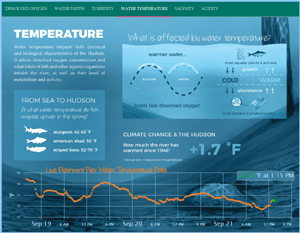 The Hudson River Environmental Conditions Observing System (HRECOS) is a network of environmental monitoring stations along the Hudson and Mohawk Rivers. The stations are equipped with sensors that continuously record water quality and weather data every 15 minutes. Most stations operate year-round, providing seasonal records across the watershed. This helps researchers understand long-term trends, short-term events such as intense storms, and manage water resources. The network also provides policy makers and emergency managers with data to guide decision-making, and is a resource for educators. The Hudson River Environmental Conditions Observing System (HRECOS) is a network of environmental monitoring stations along the Hudson and Mohawk Rivers. The stations are equipped with sensors that continuously record water quality and weather data every 15 minutes. Most stations operate year-round, providing seasonal records across the watershed. This helps researchers understand long-term trends, short-term events such as intense storms, and manage water resources. The network also provides policy makers and emergency managers with data to guide decision-making, and is a resource for educators.
Recently, two stations were added to the HRECOS network at Ferry Landing near Stuyvesant and at Bear Mountain Dock near Iona Island. Both stations are maintained by the Hudson River National Estuarine Reserve. HRECOS is a partnership between state, federal, academic, and nonprofit institutions.
Pilot Study Examines Blue-green Algae in the Hudson
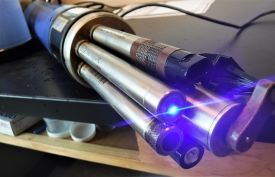 The US Geological Survey (USGS) and HRECOS partners are conducting a pilot study examining blue-green algae associated with harmful algal blooms (HABs) in the Hudson River. The study will include several techniques including direct sample collection, remote sensing satellite imagery, and real-time environmental data. Data from HRECOS network will be used to determine if remote sensing techniques can be an effective means to estimate blue-green algae in the Hudson River. Remote sensing is used to inform HABs monitoring in lake ecosystems throughout the United States, with limited research focused on tidal rivers like the Hudson River. These findings will inform future monitoring by USGS and DEC in the Lower Hudson during 2022-2023. The US Geological Survey (USGS) and HRECOS partners are conducting a pilot study examining blue-green algae associated with harmful algal blooms (HABs) in the Hudson River. The study will include several techniques including direct sample collection, remote sensing satellite imagery, and real-time environmental data. Data from HRECOS network will be used to determine if remote sensing techniques can be an effective means to estimate blue-green algae in the Hudson River. Remote sensing is used to inform HABs monitoring in lake ecosystems throughout the United States, with limited research focused on tidal rivers like the Hudson River. These findings will inform future monitoring by USGS and DEC in the Lower Hudson during 2022-2023.
|


 Water quality in the Hudson River estuary and the web of life it nourishes depends on the health of the many tributary streams and rivers that flow into its waters.
Water quality in the Hudson River estuary and the web of life it nourishes depends on the health of the many tributary streams and rivers that flow into its waters.  Each year, migratory fish navigate from the tidal Hudson to stream habitats to move between feeding, nursery, and spawning grounds. Many
Each year, migratory fish navigate from the tidal Hudson to stream habitats to move between feeding, nursery, and spawning grounds. Many 
 In 2021, the Estuary Program, in partnership with NEIWPCC, awarded a contract to the engineering firm Tighe & Bond to work with the communities of Red Hook and Milan to create
In 2021, the Estuary Program, in partnership with NEIWPCC, awarded a contract to the engineering firm Tighe & Bond to work with the communities of Red Hook and Milan to create  In 2021, the
In 2021, the 
 The Saw Kill River is a direct tributary to the Hudson River, with its watershed spanning over 16,000 acres. Its headwaters begin in Milan, NY then meander north-west to the confluence of the Hudson River at Annandale-on-Hudson. This important stream provides drinking water, recreational opportunities, and habitat for fish and wildlife. This past summer,
The Saw Kill River is a direct tributary to the Hudson River, with its watershed spanning over 16,000 acres. Its headwaters begin in Milan, NY then meander north-west to the confluence of the Hudson River at Annandale-on-Hudson. This important stream provides drinking water, recreational opportunities, and habitat for fish and wildlife. This past summer,  The
The  The
The